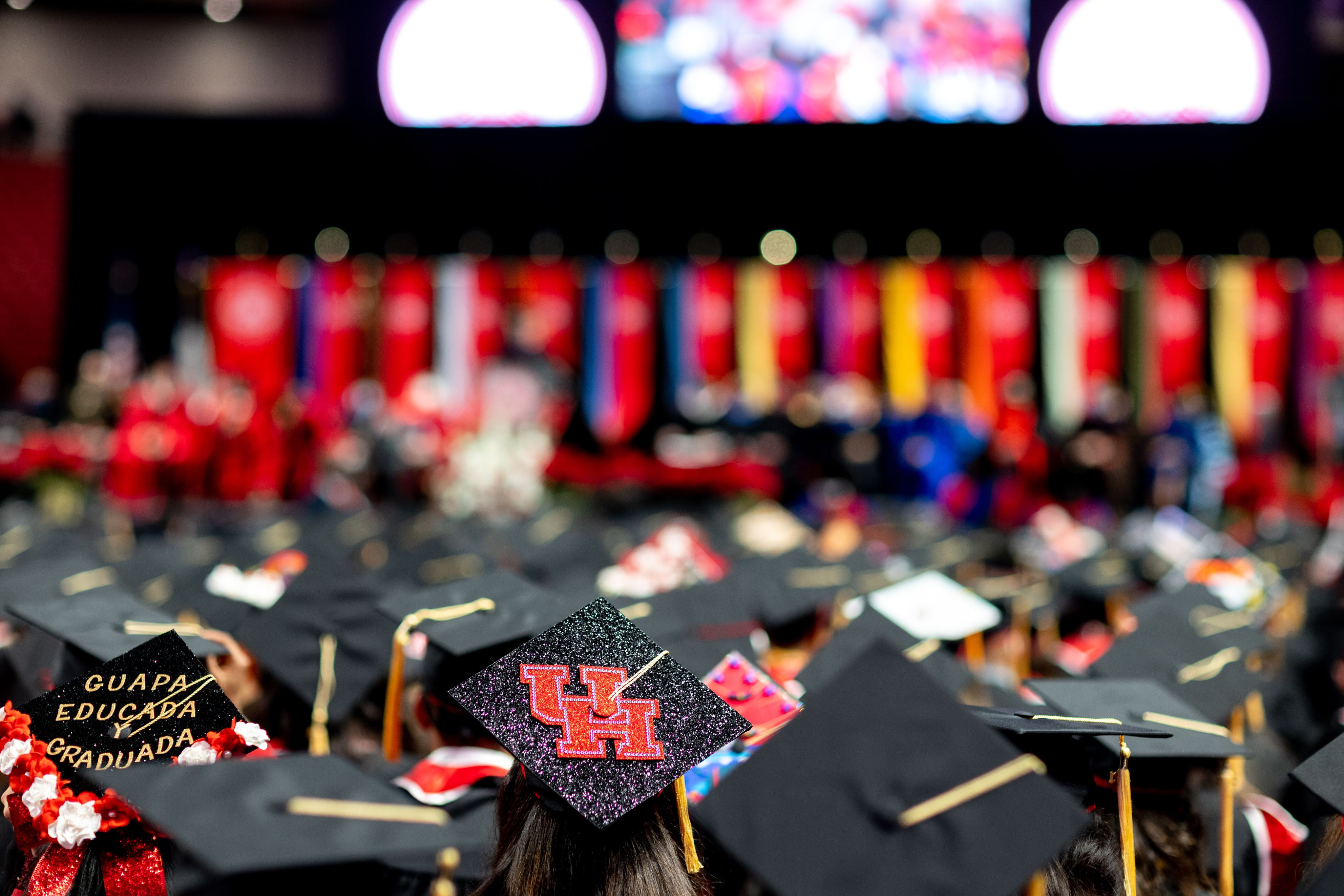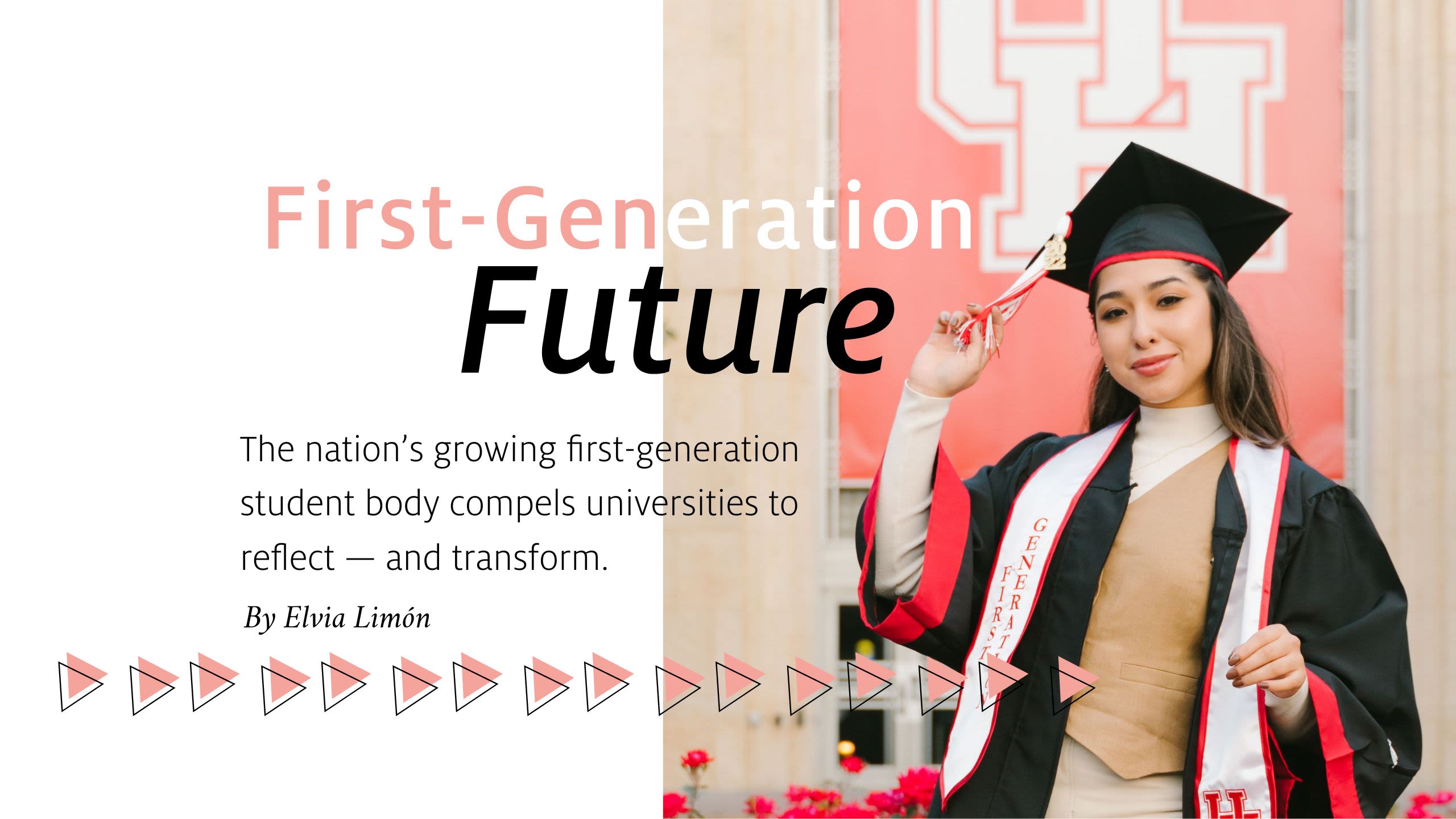
Skipping out on college was never an option for Carmen Miranda. After a rough divorce, her mother moved 5-year-old Miranda and her 6-month-old sister from Mexico City to Houston. There, her mother would have two more children.
As the oldest of four, Miranda says she feels responsible for helping her family, especially her mom. Throughout the years, she witnessed her mother put aside personal aspirations to work six days a week to provide for her children. Seeking higher education was how Miranda planned to repay her for all those sacrifices.
“I’ve heard a lot of people say, ‘This is not your responsibility. You don’t have to put so much weight on yourself,’” Miranda says. “I can’t help it. I feel like it’s my duty to graduate from college, which I did in May. The next step is to get a full-time job and excel in my career to move us forward.”
Getting into college and completing her degree at the University of Houston was challenging. Miranda was a first-generation university student, meaning her parents did not attend a four-year college. Despite her mother fully supporting her decision to pursue an advanced degree, being the first in her family to do so was, at times, lonely.
“I knew nothing,” Miranda says. “I didn’t have anyone in my close family who was able to help me. I took all the help I could get from school. And even then, my high school didn’t offer much help.”
Miranda is not alone. More and more adults have pursued advanced degrees in recent decades. The U.S. saw a total of 7.4 million college students in 1970, according to U.S. census records. In the fall of 2020, the total number of undergraduate students in the U.S. was 15.9 million, the National Center for Education Statistics reports. Among this doubling of higher-ed seekers are a wave of first-generation students.
These students often need financial support; historically, their parents make less income than those with parents who graduated from college. But other resources are equally important. These students frequently must learn how to balance their academic careers with familial responsibilities while also navigating an unfamiliar system without the safety net many other students have. For Miranda, mentorship, connection and networking made the difference.
Recognizing First-Gen Challenges
Defining who classifies as first-generation can vary depending on the institution. However, a 2018 study by the Center for First-Generation Student Success estimates that neither parent of roughly 56% of undergraduate students in the U.S. had a bachelor's degree. Like Miranda, 59% of those students were also the first sibling in their family to go to college.
For Miranda, that meant juggling school, work, internships, chores and helping care for her younger siblings with special needs. She did this while adjusting to a new normal caused by the COVID-19 pandemic, which deprived her of a more traditional college experience.
“I’m used to always doing a lot, and that’s what feels like the whole experience has been. The time during COVID was probably the worst," Miranda says. "I did hit severe depression.”
First-generation students tend to be less likely to complete their degree than students with at least one college-educated parent, according to the Pew Research Center. Around 20% of people between the ages of 22 to 59 who have parents with no advanced degrees have completed a bachelor’s degree. That number rises when at least one parent has a college degree.
They’re also less likely to complete their degree on time. Reports show that only 48% of first-generation students are on track to graduate three years after enrollment, compared to about 66% of non-first-gen students. Additionally, these students are less likely to use on-campus health, academic and work support services than their peers whose parents completed college.
I feel like it’s my duty to graduate from college, which I did in May. The next step is to get a full-time job and excel in my career to move us forward.”
These statistics are why school officials across the country say supporting first-generation students is essential. Several schools have begun developing better ways to connect students to resources.
Georgetown University created a guide to answer questions that a first-generation student’s parents might be unable to answer. Arizona Western University launched an “I Am First Gen” campaign to help students find first-generation faculty on campus. And the University of Rochester created a campaign to connect them with supportive faculty and staff.
Miranda’s alma mater is no exception. The University of Houston sits in one of the most diverse cities and the fourth-most populated one in the U.S., according to census records. Administrators know Miranda isn’t an isolated case. The school reports that more than 45% of its students identify as first-generation.
UH’s student body also reflects the region’s diversity, with Hispanic students making up the largest group at 33%. Asian American students follow them at 22%, white students at 22%, Black students at 11% and international students at 8%.
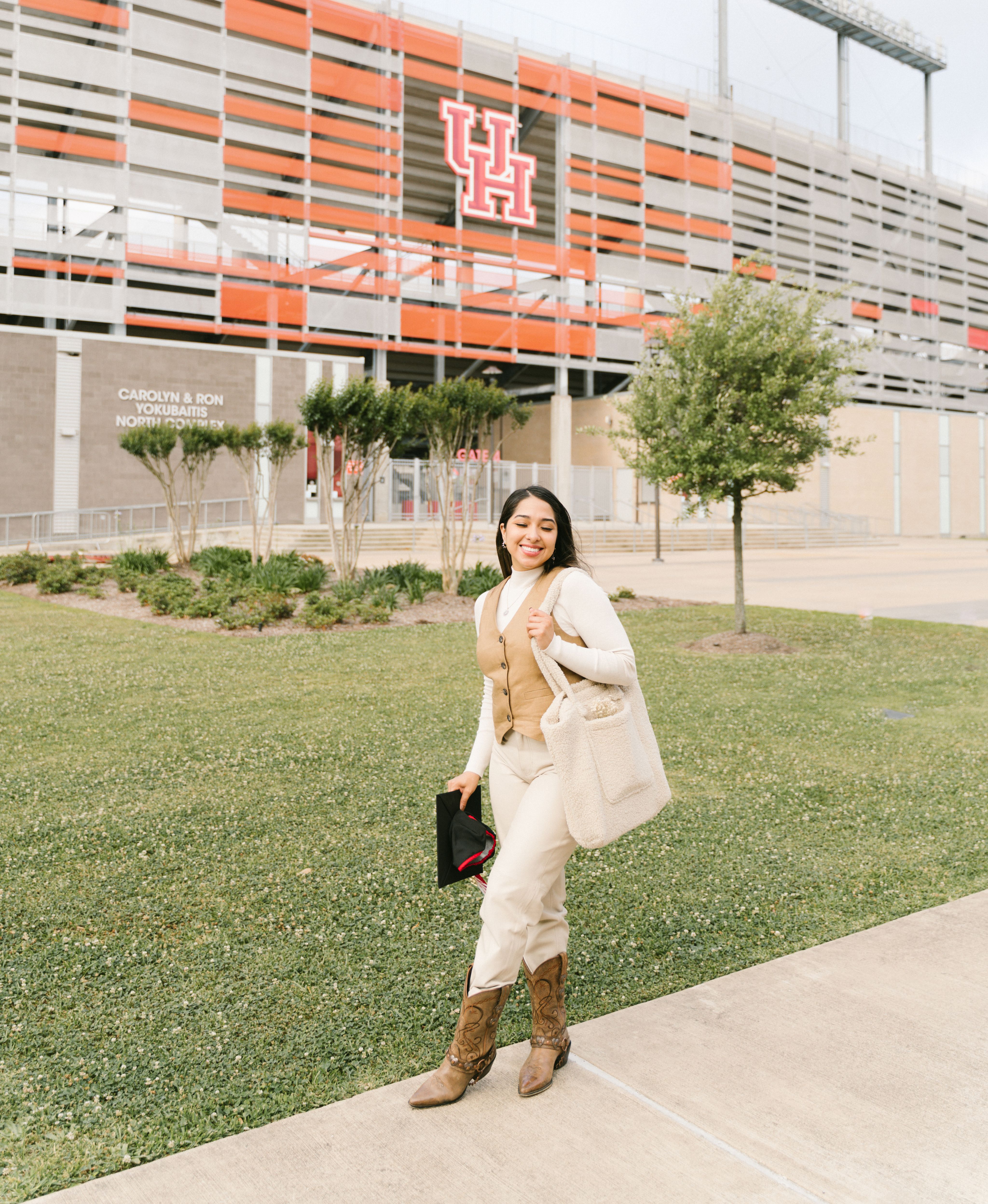
First-generation student Carmen Miranda graduated from the University of Houston with a bachelor’s degree in strategic communications in December 2022.
First-generation student Carmen Miranda graduated from the University of Houston with a bachelor’s degree in strategic communications in December 2022.
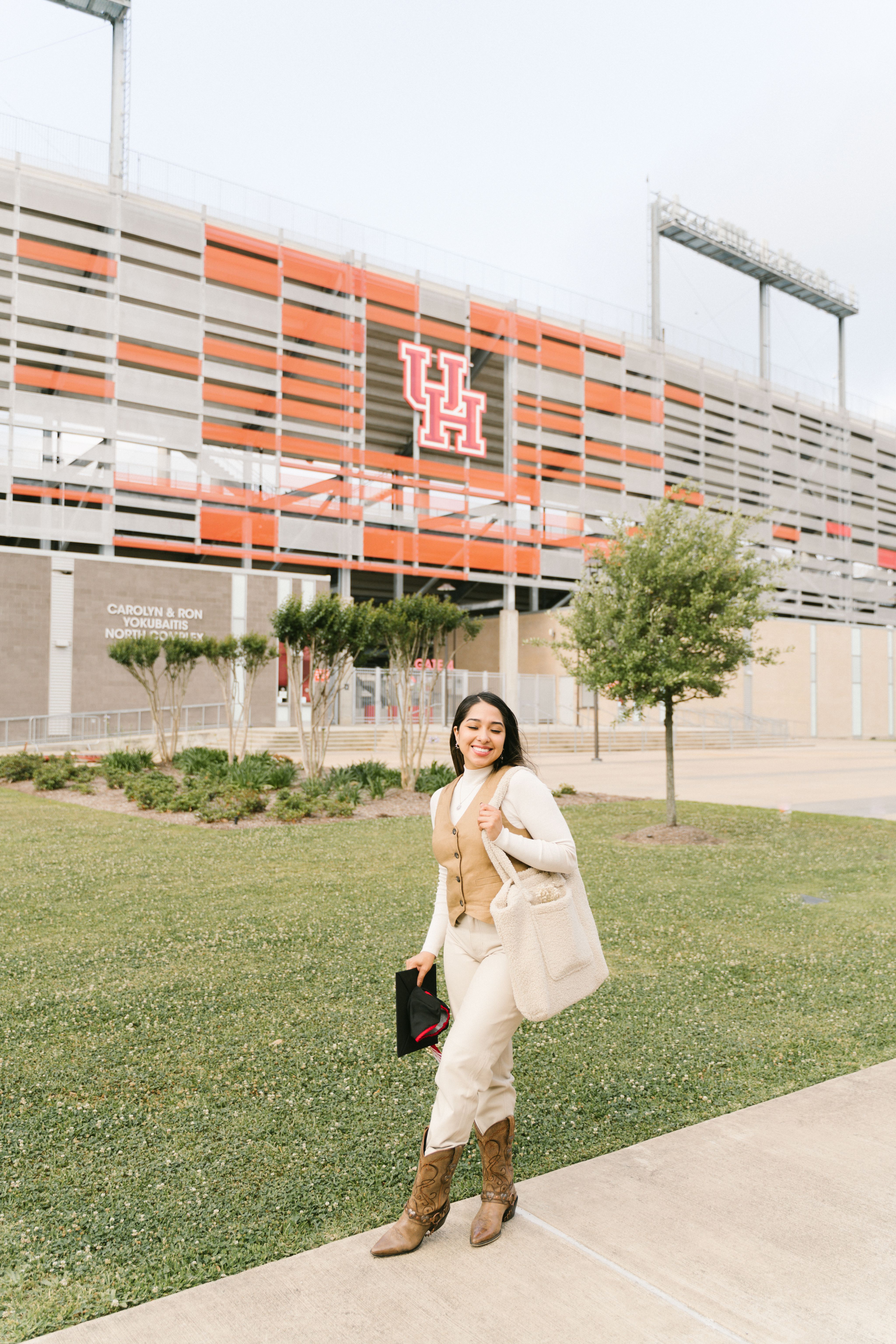
First-generation student Carmen Miranda graduated from the University of Houston with a bachelor’s degree in strategic communications in December 2022.
First-generation student Carmen Miranda graduated from the University of Houston with a bachelor’s degree in strategic communications in December 2022.
Miranda is not alone. More and more adults have pursued advanced degrees in recent decades. The U.S. saw a total of 7.4 million college students in 1970, according to U.S. census records. In the fall of 2020, the total number of undergraduate students in the U.S. was 15.9 million, the National Center for Education Statistics reports. Among this doubling of higher-ed seekers are a wave of first-generation students.
These students often need financial support; historically, their parents make less income than those with parents who graduated from college. But other resources are equally important. These students frequently must learn how to balance their academic careers with familial responsibilities while also navigating an unfamiliar system without the safety net many other students have. For Miranda, mentorship, connection and networking made the difference.
Recognizing First-Gen Challenges
Defining who classifies as first-generation can vary depending on the institution. However, a 2018 study by the Center for First-Generation Student Success estimates that neither parent of roughly 56% of undergraduate students in the U.S. had a bachelor's degree. Like Miranda, 59% of those students were also the first sibling in their family to go to college.
For Miranda, that meant juggling school, work, internships, chores and helping care for her younger siblings with special needs. She did this while adjusting to a new normal caused by the COVID-19 pandemic, which deprived her of a more traditional college experience.
“I’m used to always doing a lot, and that’s what feels like the whole experience has been,” Miranda says. “The time during COVID was probably the worst. I did hit severe depression.”
First-generation students tend to be less likely to complete their degree than students with at least one college-educated parent, according to the Pew Research Center. Around 20% of people between the ages of 22 to 59 who have parents with no advanced degrees have completed a bachelor’s degree. That number rises when at least one parent has a college degree.
They’re also less likely to complete their degree on time. Reports show that only 48% of first-generation students are on track to graduate three years after enrollment, compared to about 66% of non-first-gen students. Additionally, these students are less likely to use on-campus health, academic and work support services than their peers whose parents completed college.
I feel like it’s my duty to graduate from college, which I did in May. The next step is to get a full-time job and excel in my career to move us forward.”
These statistics are why school officials across the country say supporting first-generation students is essential. Several schools have begun developing better ways to connect students to resources.
Georgetown University created a guide to answer questions that a first-generation student’s parents might be unable to answer. Arizona Western University launched an “I Am First Gen” campaign to help students find first-generation faculty on campus. And the University of Rochester created a campaign to connect them with supportive faculty and staff.
Miranda’s alma mater is no exception. The University of Houston sits in one of the most diverse cities and the fourth-most populated one in the U.S., according to census records. Administrators know Miranda isn’t an isolated case. The school reports that more than 45% of its students identify as first-generation.
UH’s student body also reflects the region’s diversity, with Hispanic students making up the largest group at 33%. Asian American students follow them at 22%, white students at 22%, Black students at 11% and international students at 8%.
For Miranda, being a first-generation student meant juggling school, work, internships, chores and helping care for her younger siblings with special needs.

Helping Students ‘Connect the Dots’
Among those trying to make the college experience more enjoyable and more accessible for first-gen students is Raven Jones, director of the Center for Student Empowerment, which helps students solve barriers that stand in the way of graduating. Students may come in with financial or academic questions, but they can also find information on mental health, social engagement on campus and civil leadership opportunities.
“I think first-gen is a really important group to work with,” Jones says. “They have some struggles and challenges but they learned from parents that displayed awesome resiliency.”
By offering services beyond financial and academic ones — from mentorship to securing food and technology for school — the center can create a successful student, Jones says.
“We know we’re connecting,” Jones says. “Right now, with a lot of our programs, we want to scale up to reach more and more first-gen.”
One key resource the center offers is the Las Comadres College Mentoring program, which focuses on supporting first-generation Latina students — the school’s largest first-generation demographic — by connecting them with Latina faculty and staff. Through this mentorship program, students connect with other Latinas who can help them expand their professional networks, making it easier to move forward in school and into a successful career.
“They have some struggles and challenges but they learned from parents that displayed awesome resiliency.”
Jones says the students participating in any of the center’s programs tend to have an average GPA of approximately 3.2 and a 92% to 97% retention rate. That retention rate eventually leads to more overall graduations.
“Education is the great equalizer, and their parents are pushing for it,” Jones says. “But the challenge with first-generation [students] is that they’re usually facing other obstacles, like taking care of younger siblings or working.”
Hope Pacheco’s work as assistant dean of students involves giving students any specialized support they may need to graduate on track, such as linking them with help during a mental health-related crisis or while experiencing distress. She’s also one of the minds behind Las Comadres.
“It’s really about helping the students connect the dots,” Pacheco says.
Pacheco, also a first-generation student, was searching for others at the University who were already serving these students. Now a part-time doctoral student in the UH College of Education’s Higher Education Leadership and Policy Studies program, she realized firsthand that first-gen students still face barriers she’d endured more than 20 years ago. She and Jones partnered to create a program to serve first-gen students. Since the program’s start in the fall of 2016, Las Comadres has served about 150 undergraduate students.
“Our initial hope was for it to be a first-year program to help launch students and connect them with other resources and programs, but we found that students wanted to stay with our program,” Pacheco says. “So, it has expanded. It has been a joy and a beautiful experience to watch the students and mentors connect and grow.”
Pacheco is also a licensed social worker who has previously worked with primary and secondary-aged children. She’s seen the importance of helping first-gen students early on in the process and encourages students to reach out for help if they need it.
“It can be scary, but the most important thing is to reach out and build relationships,” Pacheco says. “They should trust that there are people who want to see them succeed.”

For Miranda, being a first-generation student meant juggling school, work, internships, chores and helping care for her younger siblings with special needs.

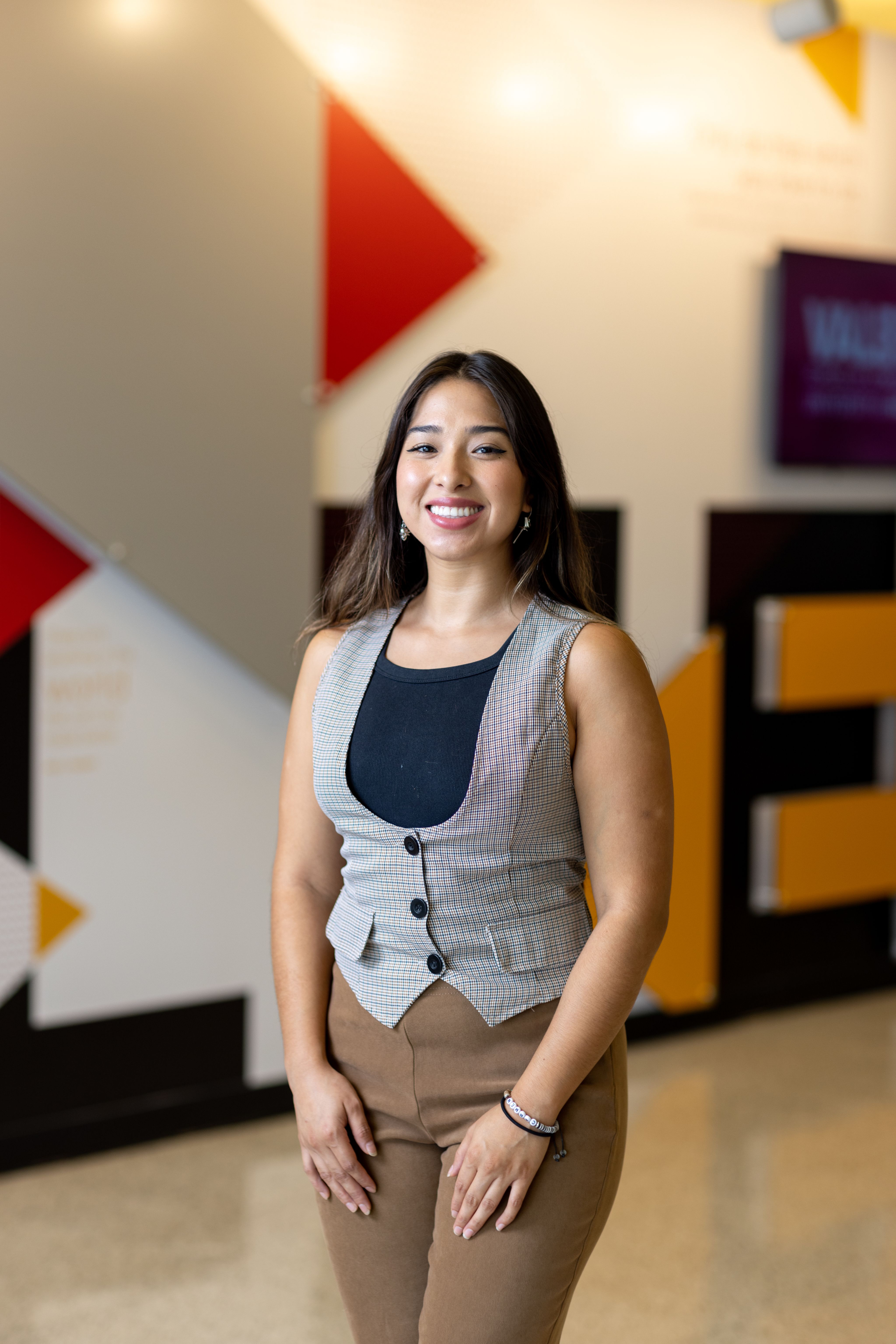
UH’s student body also reflects the region’s diversity, with Hispanic students making up the largest group at 33%. Asian American students follow them at 22%, white students at 22%, Black students at 11% and international students at 8%.
Helping Students ‘Connect the Dots’
Among those trying to make the college experience more enjoyable and more accessible for first-gen students is Raven Jones, director of the Center for Student Empowerment, which helps students solve barriers that stand in the way of graduating. Students may come in with financial or academic questions, but they can also find information on mental health, social engagement on campus and civil leadership opportunities.
“I think first-gen is a really important group to work with,” Jones says. “They have some struggles and challenges but they learned from parents that displayed awesome resiliency.”
By offering services beyond financial and academic ones — from mentorship to securing food and technology for school — the center can create a successful student, Jones says.
“We know we’re connecting,” Jones says. “Right now, with a lot of our programs, we want to scale up to reach more and more first-gen.”
One key resource the center offers is the Las Comadres College Mentoring program, which focuses on supporting first-generation Latina students — the school’s largest first-generation demographic — by connecting them with Latina faculty and staff. Through this mentorship program, students connect with other Latinas who can help them expand their professional networks, making it easier to move forward in school and into a successful career.
“They have some struggles and challenges but they learned from parents that displayed awesome resiliency.”
Jones says the students participating in any of the center’s programs tend to have an average GPA of approximately 3.2 and a 92% to 97% retention rate. That retention rate eventually leads to more overall graduations.
“Education is the great equalizer, and their parents are pushing for it,” Jones says. “But the challenge with first-generation [students] is that they’re usually facing other obstacles, like taking care of younger siblings or working.”
Hope Pacheco’s work as assistant dean of students involves giving students any specialized support they may need to graduate on track, such as linking them with help during a mental health-related crisis or while experiencing distress. She’s also one of the minds behind Las Comadres.
“It’s really about helping the students connect the dots,” Pacheco says.
Pacheco, also a first-generation student, was searching for others at the University who were already serving these students. Now a part-time doctoral student in the UH College of Education’s Higher Education Leadership and Policy Studies program, she realized firsthand that first-gen students still face barriers she’d endured more than 20 years ago. She and Jones partnered to create a program to serve first-gen students. Since the program’s start in the fall of 2016, Las Comadres has served about 150 undergraduate students.
“Our initial hope was for it to be a first-year program to help launch students and connect them with other resources and programs, but we found that students wanted to stay with our program,” Pacheco says. “So, it has expanded. It has been a joy and a beautiful experience to watch the students and mentors connect and grow.”
Pacheco is also a licensed social worker who has previously worked with primary and secondary-aged children. She’s seen the importance of helping first-gen students early on in the process and encourages students to reach out for help if they need it.
“It can be scary, but the most important thing is to reach out and build relationships,” Pacheco says. “They should trust that there are people who want to see them succeed.”

Moving a Community Forward
Applying for college is a multistep process that starts in the last few years of high school. Students must meet college prep coursework and move through the admissions and financial aid process. But this already complicated procedure becomes even more difficult when you’re a first-gen student. Approximately 65% of high school seniors complete a Free Application for Federal Student Aid (FAFSA) each year, and first-generation and low-income students are less likely to complete the application, the National Center for Education Statistics found in 2020.
Not having family members familiar with the FAFSA process can often cause first-generation students to make mistakes and miss out on financial opportunities while applying for financial aid.
As they continue with college, lack of guidance about college and career development from family members can also add pressure. That’s why Jones and Pachecho agree it’s important to include parents in the conversations and give them ways of supporting their first-generation college children. Jones says parents of first-generation students have told her they felt supported by the programs offered because it made them feel like the University understood their challenges.
“We have conversations with parents who will let us know, ‘I don’t know what I’m doing,’” Jones says. “But they know they can relax because we can also guide them in this journey.”

Robert McPherson, interim senior vice president for academic affairs and provost
Robert McPherson, interim senior vice president for academic affairs and provost

“I think it’s very easy to feel like you’re getting buried down or getting lost. There’s a lot of help if you look for it."
Helping first-generation students doesn’t only have to happen through robust programs. Professors and other staff can help by regularly checking in to ask how they’re doing, says Robert McPherson, interim senior vice president for academic affairs and provost.
“At times, these kids feel invisible,” he says. “I think it helps to encourage kids by asking them things like, ‘What kind of things do you want to do in life?’ If you can’t help them directly, you can point them in the right direction.”
He also encourages faculty and staff to continue to reach out to first-generation students, because they never know what will resonate.
“I’ve had students reach out telling me about how I did or said something in class or a hallway conversation that I didn’t think was terribly profound or motivating but that they took to heart,” McPherson says. “There’s nothing better for a faculty member than to get a note from a former student thanking them for supporting them or believing in them.”
As a first-generation graduate himself, McPherson says that helping first-gen students succeed also helps their communities move forward. “They are going to be the doctors, lawyers, teachers, nurses, business entrepreneurs and leaders of the future,” he says.
Miranda says one of her lifelines at UH was a professor who referred her to a program that connected her with professionals across the country.
Now that she has graduated with a degree in strategic communications, the program has allowed her to travel. Those opportunities have opened her to the possibility of moving outside Houston and Texas. Where to? Possibly Charlotte, North Carolina, but she is still unsure.
As she joins the job search, Miranda says she is sure she would help first-gen students find their way through school the way others helped her. “I think it’s very easy to feel like you’re getting buried down or getting lost,” Miranda says. “There’s a lot of help if you look for it.”
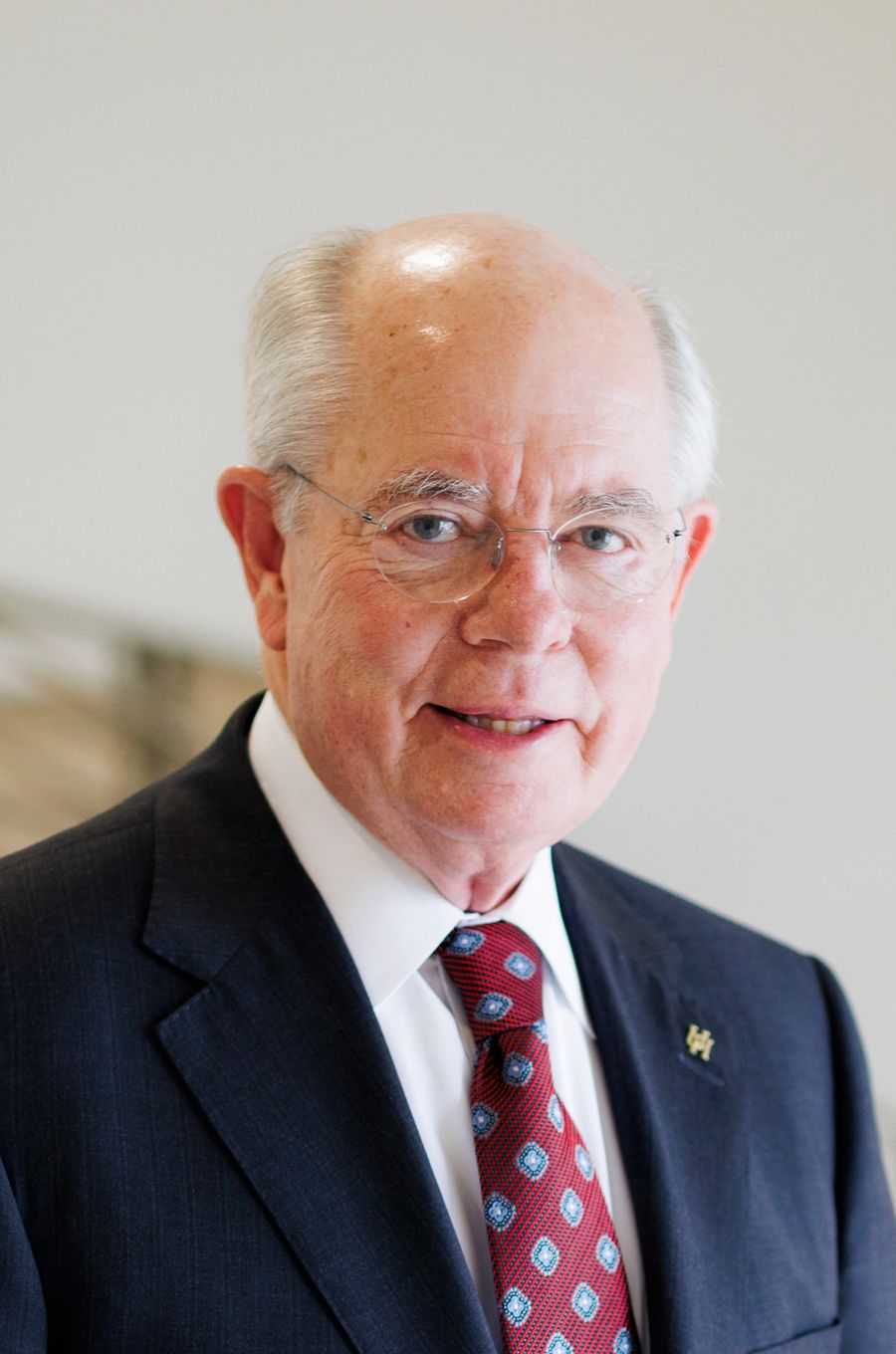
Robert McPherson, interim senior vice president for academic affairs and provost
Robert McPherson, interim senior vice president for academic affairs and provost
Helping first-generation students doesn’t only have to happen through robust programs. Professors and other staff can help by regularly checking in to ask how they’re doing, says Robert McPherson, interim senior vice president for academic affairs and provost.
“At times, these kids feel invisible,” he says. “I think it helps to encourage kids by asking them things like, ‘What kind of things do you want to do in life?’ If you can’t help them directly, you can point them in the right direction.”
He also encourages faculty and staff to continue to reach out to first-generation students, because they never know what will resonate.
“I’ve had students reach out telling me about how I did or said something in class or a hallway conversation that I didn’t think was terribly profound or motivating but that they took to heart,” McPherson says. “There’s nothing better for a faculty member than to get a note from a former student thanking them for supporting them or believing in them.”
As a first-generation graduate himself, McPherson says that helping first-gen students succeed also helps their communities move forward. “They are going to be the doctors, lawyers, teachers, nurses, business entrepreneurs and leaders of the future,” he says.
"I think it’s very easy to feel like you’re getting buried down or getting lostThere’s a lot of help if you look for it."
Miranda says one of her lifelines at UH was a professor who referred her to a program that connected her with professionals across the country.

Now that she has graduated with a degree in strategic communications, the program has allowed her to travel. Those opportunities have opened her to the possibility of moving outside Houston and Texas. Where to? Possibly Charlotte, North Carolina, but she is still unsure.
As she joins the job search, Miranda says she is sure she would help first-gen students find their way through school the way others helped her. “I think it’s very easy to feel like you’re getting buried down or getting lost,” Miranda says. “There’s a lot of help if you look for it.”
“They are going to be the doctors, lawyers, teachers, nurses, business entrepreneurs and leaders of the future.”
— Robert McPherson

